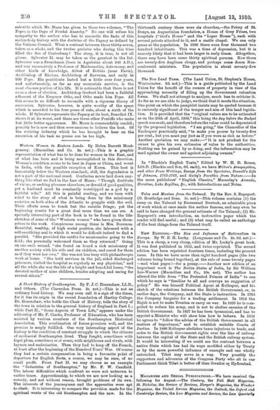A Short History of Southampton. By F. J. C. Hearnshaw,
LL.D., and Others. (The Clarendon Press. 2s. net.)—This is not an ordinary local history. We may even call it a sign of the times, for it has its origin in the recent foundation of Hartley College. Dr. Hearn.3haw, who holds the Chair of History, tells the story of the town in relation to the general history of England in Part I.; while Part IL, "Some Aspects of Town Life," appears under the editorship of Mr. F. Clarke, Professor of Education, who has been assisted by various members of the Southampton Historical Association. This combination of forces promises well, and the promise is amply fulfilled. One very interesting aspect of the history is the condition of constant struggle in which the citizens of mediaeval Southampton lived. They fought, sometimes with legal pleas, sometimes vi et armis, with neighbours and rivals, with laymen and ecclesiastics. Then they had to keep off the French, at least after tho beginning of the Hundred Years' War. Of course they had a certain compensation in being a favourite point of departure for English fleets, a source, wo may be sure, of no small profit. From Part II. we may choose as an example the "Industries of Southampton," by Mr. F. W. Camfield. The labour difficulties which confront us were not unknown to earlier times. Apprenticeship, to which we are now looking as a
• remedy, and not without reason, brought problems of its own. The interests of the journeyman and the apprentice were apt . to clash. It is interesting to compare the provision made for the spiritual wants of the old Southampton and the new. In the
thirteenth century there were six churches,—the Priory of St. Denys, an Augustinian foundation, a House of Grey Friars, two hospitals ("God's House" and the "Leper House"), each with several priests attached to it, and a castle chapel. We can only guess at the population. In 1596 there were four thousand two hundred inhabitants. This was a time of depression, but it is scarcely likely that it had been larger in early times. Altogether, there may have been some thirty spiritual persons. Now there are twenty-five Anglican clergy, and perhaps some dozen Non- conformist ministers. The population is about seventy-five thousand.






































 Previous page
Previous page